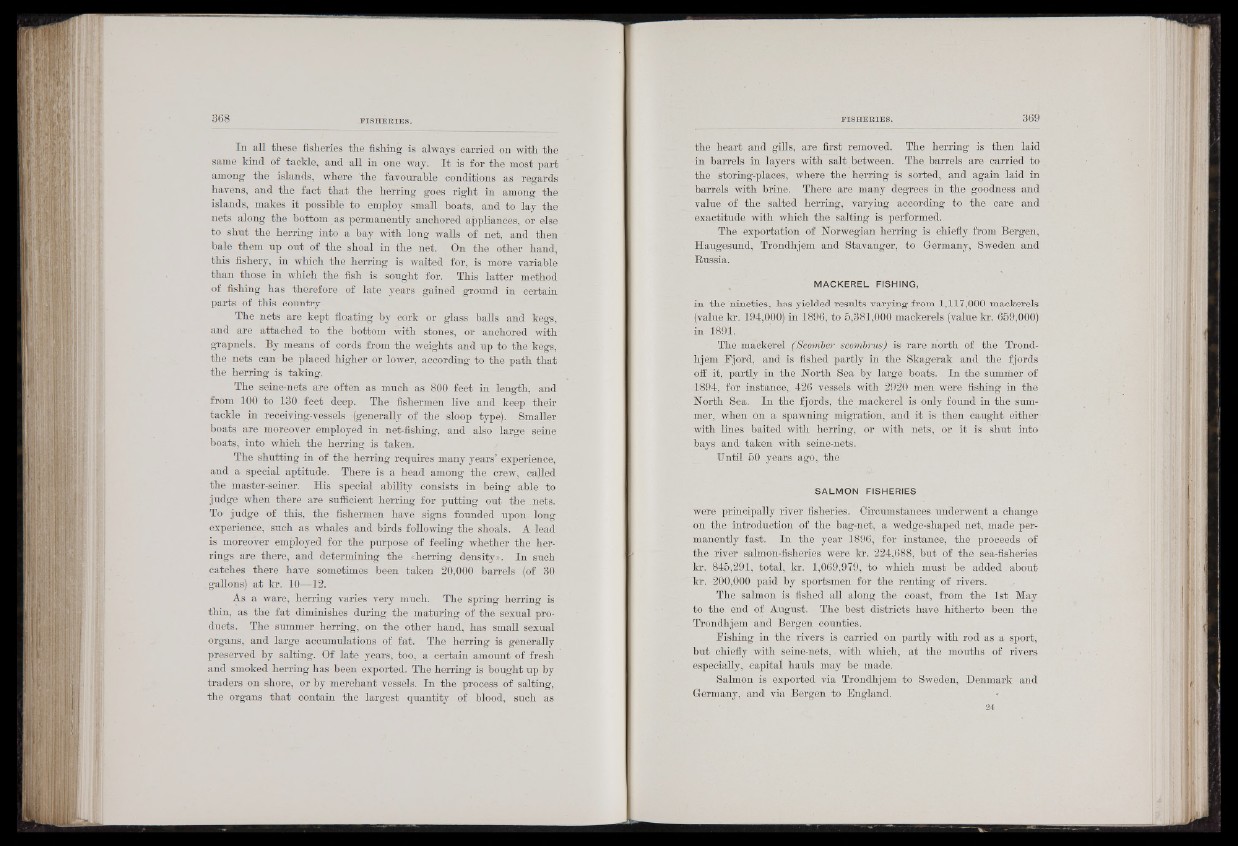
In all these fisheries the fishing Is always carried on with the
same kind of tackle, and all in one way. I t is for the most part
among the islands, where the favourable conditions as regards
havens, and the fact that the herring goes right in among the
islands, makes it possible to employ small boats, and to lay the
nets along the bottom as permanently anchored appliances, or else
to shut the herring into a bay with long walls of net, and then
bale them up out of the shoal in the net. On the other hand,
this fishery, in which the herring is waited for, is more variable
than those in which the fish is sought for. This latter method
of fishing has therefore of late years gained ground in certain
parts of this country.
The nets are kept floating by cork or glass balls and kegs,
and are attached to the bottom with stones, or anchored with
grapnels. By means of cords from the weights and up to the kegs,
the nets can be placed higher or lower, according, to the path that
the herring is taking.
The seine-nets are often as much as 800 feet in length, and
from 100 to 130 feet deep. The fishermen live and keép their
tackle in receiving-vessels (generally of the sloop type). Smaller
boats are moreover employed in net-fishing, and also large seine
boats, into which the herring is taken.
The shutting in of the herring requires many years’ experience,
and a special aptitude. There is a head among the crew, called
the master-seiner. His spècial ability consists in being able to
judge when there are suflicient herring for putting out the .nets.
To judge of this, the fishermen have signs founded upon long
experience, such as whales and birds following the shoals. A lead
is moreover employed for the purpose of feeling whether the herrings
are there, and determining the «herring density». In such
catches there have sometimes been taken 20,000 barrels (of 30
gallons) at kr. 10—12.
As a ware, herring varies very much. The spring herring is
thin, as the fat diminishes during the maturing of the sexual products.
The summer hérring, on the other hand, has small sexual
organs, and large accumulations of fat. The herring is generally
preserved by salting. Of late years, too, a certain amount of fresh
and smoked herring has been exported. The herring is bought up by
traders on shore, or by merchant vessels. In the process of salting,
the organs that contain the largest quantity of blood, such as
the heart and gills, are first removed. The herring is then laid
in barrels in layers with salt between. The, barrels are carried to
the storing-places, where the herring is sorted, and again laid in
barrels with brine. There are many degrees in the goodness and
value of the salted herring, varying according to the care and
exactitude with which the salting is performed.
The exportation of Norwegian herring is chiefly from Bergen,
Haugesund, Trondhjem and Stavanger, to Germany, Sweden and
Russia.
MACKEREL FISHING,
in the nineties, has yielded results varying from 1,117,000 mackerels
(value kr. 194,000) in 1896, to 5,381,000 mackerels (value kr. 659,000)
in 1891.
The mackerel (8comber seombrm) is rare north of the Trondhjem
Fjord, and is fished partly in the Skagerak and the fjords
off it, partly in the North Sea by large boats. In the sumiiier of
1894, for instance,. 426 vessels with 2920 men were fishing in the
North Sea. In the fjords, the mackerel is only found in the summer,
when on a spawning migration, and it is then caught either
with lines baited with herring, or with nets, or it is shut into
bays and taken with seine-nets.
Until 50 years ago, the
SALMON FISHERIES
were principally river fisheries. Circumstances underwent a change
on the introduction of the bag-net, a wedge-shaped net, made permanently
fast. In the year 1896, for instance, the proceeds of
the river salmon-fisheries were kr. 224,688, but of the sea-fisheries
kr. 845,291, total, kr. 1,069,979, to which must be added about
kr. 200,000 paid by sportsmen for the renting of rivers.
The salmon is fished all along the coast, from the 1st May
to the end of August. The best districts have hitherto been the
Trondhjem and Bergen counties.
Fishing in the rivers is carried on partly with rod as a sport,
but chiefly with seine-nets, with which, at the mouths of rivers
especially, capital hauls may be made.
Salmon is exported via Trondhjem to Sweden, Denmark and
Germany, and via Bergen to England. *
I 24